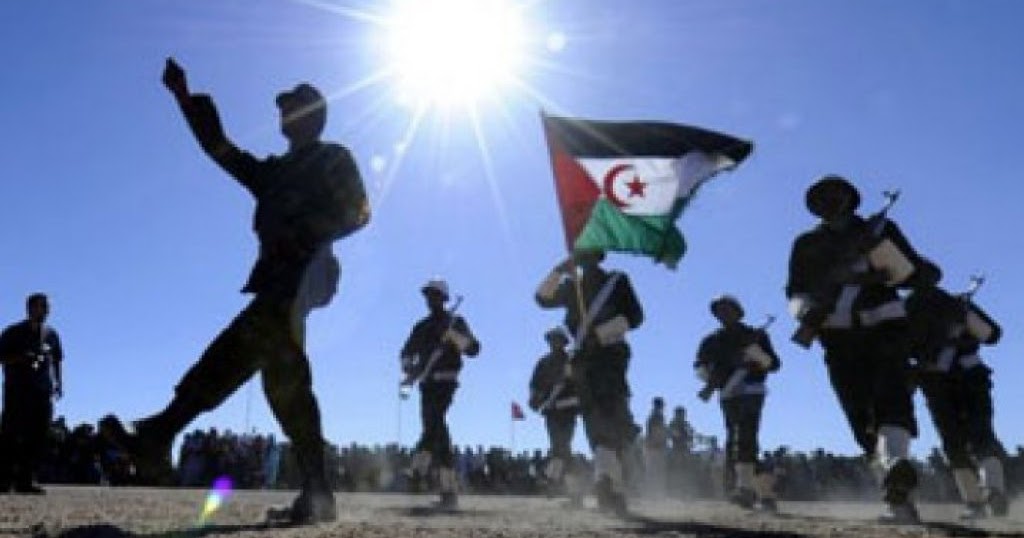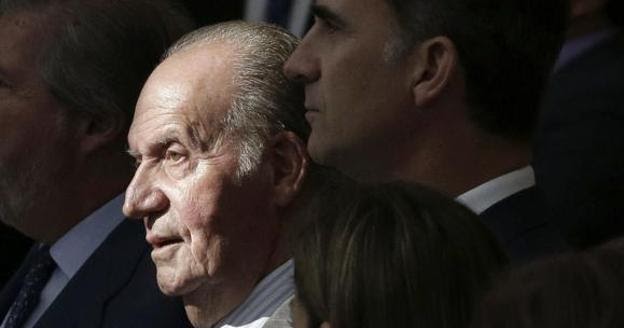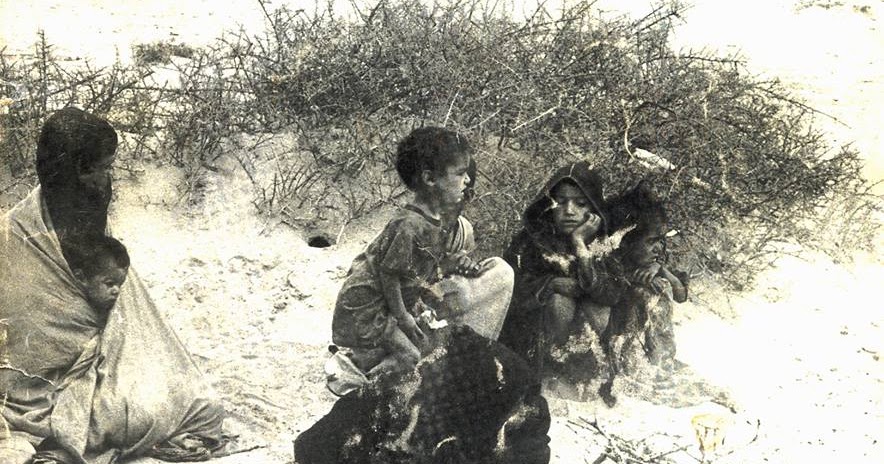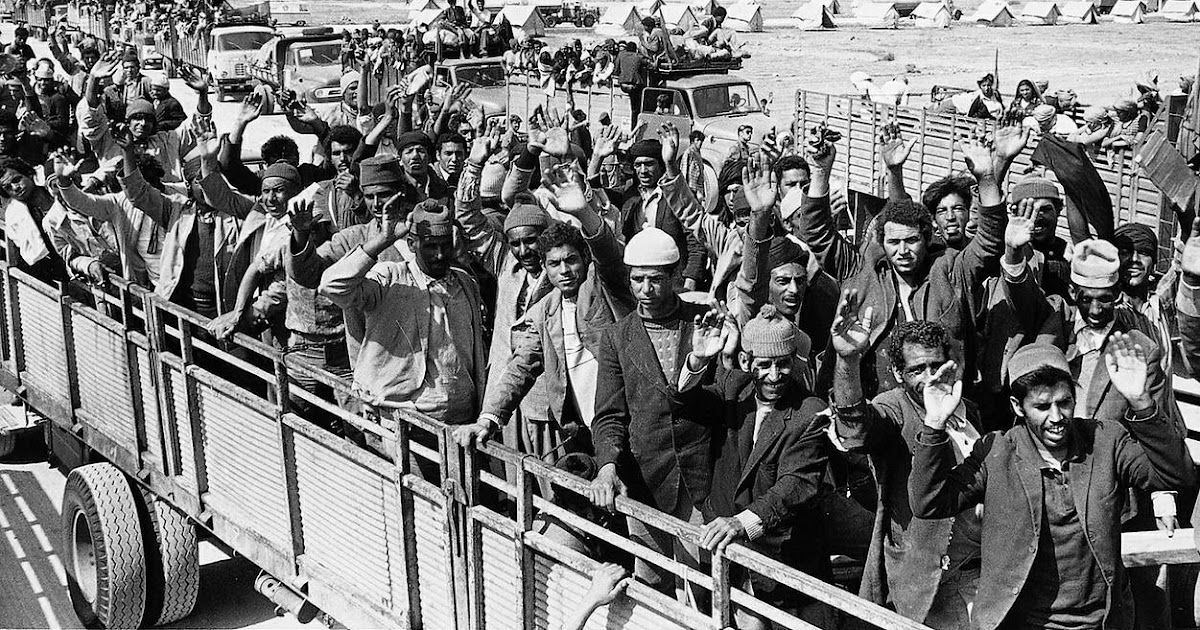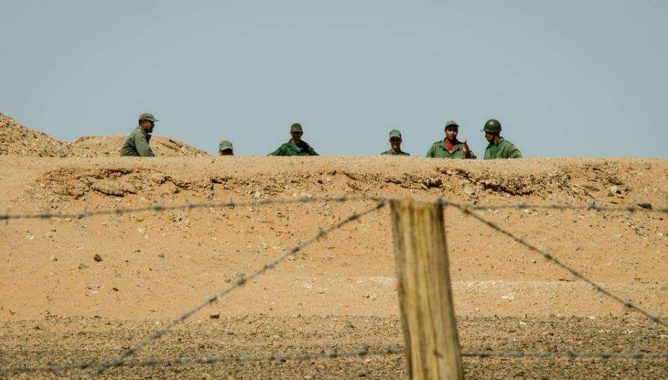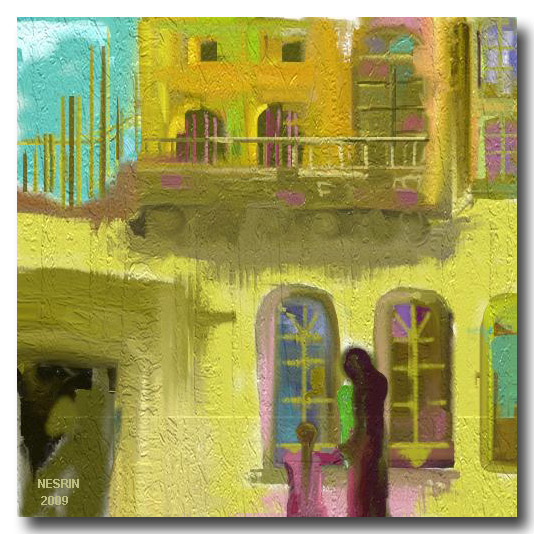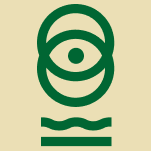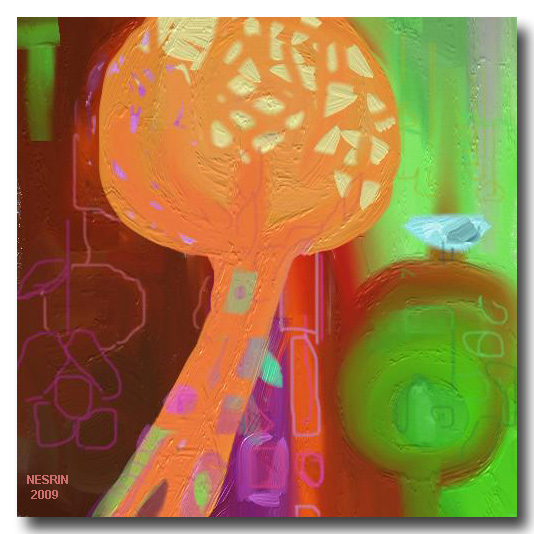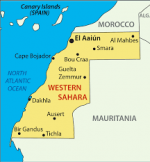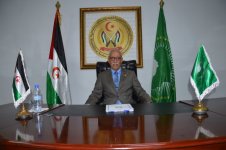Occupied Western Sahara
Date Tuesday 3 March 2020 Written by S. Guardian
Flag of the SADR
Western Sahara is considered the last colony in Africa and the second Arab colony after Palestine, and the most absent issues in the progressive and popular circles in the Arab world, and this can be traced back to several reasons, including the bias of the existing dictatorial regimes against the Moroccan occupation, the media bias that deliberately neglects the voice of the Sahrawi people and portrays the issue from the perspective of the Moroccan regime. . It can also be said that the strong cohesion that prevailed between the Sahrawi revolutionaries and the Arab progressive forces in the 1970s and 1980s witnessed a cooling off in the past decades, which affected the presence of the issue within the Arab liberation context.
In order to properly return the Saharan issue to Arab attention, we must place it in the historical and political context of the Maghreb in general, and read it in light of the struggle of the colonial powers and their client regimes and the people's will for freedom, so in this article we will review the most important historical milestones that this issue has fought and learn about the people's struggles. Desert.
Map of the desert republic
How do we learn about the Western Sahara?
Western Sahara [1] is located in northwest Africa, along the Atlantic Ocean. It is bordered by Morocco on the north, Mauritania on the south and east, and Algeria on the northeastern part. The area of desert land is about 266 thousand square kilometers, and it contains very important natural resources such as fish wealth (the coasts of the region extend over an area of 1110 km).
The city of Dakhla is an agricultural region [2] that produces high-quality varieties, especially of tomatoes, and the Western Sahara has a huge wealth of phosphates. In the Boukraa area near the city of Laayoune there is the largest single mine of phosphate in the world [3]. The Western Sahara is rich in minerals such as gold and ruby. And uranium, which is subject to exploitation under heavy guard from the Moroccan army and the gendarmerie, especially in the Kalibat al-Fula area and Lahjira, which lies 200 km south of Dakhla [4].
As for the Sahrawi people, it is known that they have Arab-Berber origins, and are made up of a group of tribes that have merged with each other and formed the Saharan culture. Hassani is the official dialect of Western Sahara, and it is a mixture of Classical Arabic and Sanhaji Berber.
The tribes formed a political and social organization with a federal feature that is distinct from the rest of the political organizations in the region, which is known as the “Ayt Forty” council, this political organization that prevailed before and during the Spanish colonialism. The Western Sahara did not know any authority of the neighboring regimes, but rather its relations with them are summarized in historical and religious relations, as evidenced by the decision of the International Court of Justice in 1973 [5].
A History of Colonial Divisions
The strategic location of Western Sahara [6], as a land and sea passage for commercial caravans to and from Africa, in addition to its rich beaches, is a major impetus for the colonial campaigns that reached the shores of Africa at the end of the fourteenth century and the beginning of the fifteenth century in search of raw materials and new consumption markets.
As the rapid growth of capitalism in Europe led to an increase in colonial ambitions that fought over the domains of influence and wealth, so the Berlin Agreement of 1884 was the beginning of the expansion of these powers in Africa, where Spain was formally granted influence over Western Sahara, but it remained for fifty years to exist in the region through trade agreements. In the years 1884 until 1887 with the desert tribes, which among its provisions was that their presence remained confined to the desert beaches of "Boujdour", "La Bouira" and "Dakhla", and not to be exposed to any desert or to penetrate into the rest of the regions.
Spain continued to be active in the desert shores in this way until 1934, when it decided to extend its influence over the entire desert soil through a military invasion [7], which led to a clash with the resistance that had mobilized the Sahrawi community to fight the armed battles against this invasion, which has witnessed its climax since the year. 1957 in battles such as “Dashira”, “Lillat” and “Akfion” in which Spain and France cooperated against the Sahrawi resistance, which led to the fall of hundreds of martyrs; The bodies of a number of them lie in the martyrs' cemetery in the “Le Palat” area -150 km near the city of Dakhla [8].
Resistance to Spanish colonization
After the increasing pace of colonial exploitation of the Saharan wealth in exchange for the suffering, deprivation and poverty that prevailed in the lives of the Sahrawi people, a group of youth and workers in the mid-sixties began to hold secret meetings aimed at developing methods of resistance to respond to the escalating colonial oppression.
Hence, the avant-garde movement to liberate Sakia El Hamra and the Valley of Gold (Western Sahara) [9] at the end of 1969, led by the deceased Sayed Ibrahim Labseer (Basiri), whose goals were to mobilize the masses of workers and hard-workers to organize protests and the complete liberation of Western Sahara from the Spanish occupation and the establishment of an independent state.
On June 17, 1970, the movement organized a peaceful demonstration in the city of El-Ayoun against the Spanish colonial policy, called “Zamaleh” [10], in which slogans were raised rejecting integration, demanding the teaching of Arabic and Spain’s exit, condemning the displacement of Sahrawi youth, setting a time for Spain’s withdrawal, and stopping settlement Spanish and controlling resources.
This peaceful demonstration was met with the force of arms by the Spanish colonialism, when a large number of Sahrawis were killed and wounded and hundreds were imprisoned, among them was the leader of the movement Basiri, whose fate Spain refuses to reveal today!
Despite the brutality of the colonial response that eliminated the vanguard organization, this was a motive for the development of the resistance under the new circumstances. In this context, a group of Sahrawi youths sought to prepare for the establishment of a political-military movement capable of waging the liberation battle against the Spanish colonialist and leading the Sahrawi masses to achieve their goal of freedom and independence .. so it was
The birth of the Popular Front for the Liberation of Saguia El Hamra and the Valley of Gold (Polisario Front) on May 10, 1973, during its first conference that decided to establish its military and political wings, using armed struggle as a means of resistance with the aim of independence and freedom for the Sahrawi people.
It defined itself as: “A national liberation movement, the fruit of a long Sahrawi resistance against various forms of foreign occupation, within which all Sahrawis who believe in the principles of the May 20 Revolution fall and are committed to respecting its Basic Law and implementing its national program of action in their struggle for complete independence. And the restoration of the sovereignty of the Sahrawi people ”[11].
The Polisario Front adopted “the discourse of armed struggle and revolutionary violence,” as it made clear in its founding statement of May 10, 1973, by saying that, in view of colonialism's clinging control in the region, it uses “revolutionary violence and armed action as a means to bring the Sahrawi Arab-African people to comprehensive freedom from Spanish colonialism and striking their conspiracies. “This matter was embodied in the first military battle, which was the liberation of the revolutionary bomber, the martyr, and some of his companions from the prison, where the first military cell consisted of 45 fighters, and the first military operation was carried out on May 20, 1973,“ Operation Choke ”[12].
Although the armed struggle began with hunting rifles, the resistance practiced the methods of "guerrilla warfare" and then the resistance experienced a rapid growth, especially after the increasing enrollment in its ranks and its acquisition of modern equipment after its capture from the enemy [13] until it became able at the end of 1974 to engage in specific guerrilla actions. , The most prominent of which was the bombing of the conveyor belt of phosphates, because it is considered an important and influential economic artery for the colonizer. The operation was carried out on October 20, 1975 [14].
In the face of repeated attacks, the Spanish forces were forced to withdraw from many areas in the face of the successive strikes of the People's Liberation Army, which made them enter into negotiations with the Polisario Front on September 9, 1975, to feel the pulse of compromise. In front of the Sahrawi's adherence to independence and complete sovereignty over the wealth, a new chapter in the Saharan issue will begin, which extends to today.
Neighbors stabs in the back
In contrast to the leftist movements in Mauritania (the toilers movement) and the Forward movement (the basic democratic approach) in Morocco [15] - which supported the Sahrawi revolutionaries and expressed their support for them, as many cadres of the toiling movement volunteered in the political and military wing of the Polisario, and the Moroccan regime arrested leaders from Forward because of their support for the Sahrawi cause - the puppet regimes in Morocco and Mauritania influenced the completion of the Sahrawi revolution and betrayed their people. As the Sahrawi revolution posed a threat to the interests of colonialism and the interests of its proxies in the region, after the three coup attempts that the Moroccan monarchy lived and the growing popular protests against economic marginalization and with the subordination of the Mauritanian regime to France, Spain, America and France agreed with the Moroccan and Mauritanian regimes to invade and divide them and preserve the interests of Western Sahara. Economic Spain in exchange for American and French support for these systems.
This was preceded by security and military coordination between Spain, Morocco and Mauritania, after the escalation of the armed struggle, where the security pursuit and physical liquidation against youth and students studying in these countries formed the bulk of the comprehensive political and military coordination process, which witnessed an escalation and intensity in the last months of 1975, and the Madrid Agreement was The actual translation of this collusion was signed between the Moroccan occupation state, the Islamic Republic of Mauritania and the Kingdom of Spain [16].
Under this agreement on November 14, 1975, Western Sahara was divided into two halves: the northern part was occupied by the Kingdom of Morocco and the southern part witnessed an invasion by Mauritania. This agreement consists of:
A document called the “Declaration of Principles”, which stipulates the process of dividing the land - the Western Sahara occupied at the time by Spain - between Morocco and Mauritania, in addition to a set of agreements related to fishing and economic and industrial cooperation, and it became clear later that Spain’s concession was in exchange for its involvement in the exploitation of phosphate mines. In the desert lands, and the survival of its fishing fleet in the territorial waters of the desert and with the guarantee of two military bases off the Canary Islands. The secret documents disclosed by the CIA [17] recently clarified how the then US Secretary of State Henry Kissinger formed the cornerstone of this agreement by engineering the Madrid Agreement that provides for the surrender of Western Sahara to Morocco and Mauritania in exchange for full US political support in his future career as king of Spain. 18].
According to the agreement, Spain tried to evade its legal responsibility to complete the decolonization of the territory, which was supposed to be organized in the same year [19]. Here it should be noted that, through Morocco's support for this referendum and the right of the Sahrawi people to decide their own destiny before deciding to enter into their occupation, the representative of Morocco, “Day Ould Sidi Baba,” announced during the meeting of the Special Committee on June 17, 1966 in Addis Ababa (Ethiopia) that “ Morocco affirms that all lands under the domination of Spanish colonialism must be liberated, ”adding that“ the Moroccan government proposes its independence in the shortest time. ” During the next session of the Special Committee, the Commissioner of Morocco emphasized that “since 1966, Morocco has been calling for self-determination of the inhabitants of Western Sahara and freedom of independence” [20].
Months before the signing of this agreement, an international fact-finding mission in May 1975 visited the cities of El-Ayoun and Dakhla [21], with the aim of studying the political, social and demographic data to conduct the self-determination referendum demanded by the United Nations since 1966 [22].
It issued its report on October 15 of the same year, a few days before the Moroccan and Mauritanian military invasions of the region. And in which the Sahrawi masses received the mission with pictures of the desert flag
And slogans such as “Voeira España” (Get out of Spain), calling for the life of the Polisario as the sole representative of the Sahrawi people, and the report also expressed the Sahrawi’s desire for independence and their refusal to join any of the neighboring countries [23].
In response to this agreement, and as an expression of the Sahrawi people's desire for independence and the rejection of dependency and occupation, the Popular Front for the Liberation of Sakia El Hamra and the Valley of Gold, led by the guardian martyr Mostafa El-Sayed, announced on February 27, 1976, that is, one day after the evacuation of the last Spanish soldier, the establishment of the SADR, the embodiment of The aspirations and hopes of the Sahrawi people and their martyrs for freedom [24].
The Moroccan-Mauritanian invasion
The year 1975, exactly since October and November, was the year of escalation of the campaign of extermination and killing that the Sahrawi people lived through, and a terrible period in which the Moroccan monarchy exploded its violence against the Sahrawi people [25]. After the signing of the Madrid Agreement, this campaign took the character of a comprehensive genocide that was translated into kidnappings, mass arrests, and physical liquidations that included entire families using Nazi methods represented by burning families alive, throwing people from planes alive and burying them in mass graves and rape of women in front of their husbands and fathers, where sexual assault was used as a weapon. A war against Sahrawi women, their breasts were cut and tortured, and whoever the invaders could not arrest or kill, he was subjected to persecution and revenge on his family [26].
It must be mentioned in this context that Spain has handed over to Morocco all its archives of intelligence on lists and files related to militants and women activists that served as useful guidance in pursuing the revolutionary organization and its activists and committing genocide massacres [27].
During the Moroccan-Mauritanian invasion, thousands of Sahrawis, displaced from their lands, immigrated to southern Algeria, which opened its borders to refugees to save their lives from the Moroccan and Mauritanian regime, which invaded their homeland using tanks, planes and missiles. There were thousands of martyrs and hundreds of wounded among the desert camps (Umm Dreika, Tafariti, and Akti) [28] that sheltered more than 25,000 people, mostly women, elderly and children, according to the Sahrawi Red Crescent sources at the time (see the issue of the Free Sahara newspaper in March). 1976) [29].
On October 16, 1975, Hassan II announced the “Green March” [30] days before the official announcement of the Madrid Agreement, whereby this settlement march would be a cover for the military invasion and on October 26, 1975, it began to be organized in Moroccan territory with logistical planning and organization of American technicians. With the participation and support of Saudi Arabia [31].
At the beginning of November, the “Green March” invaded Western Sahara [32] under the secret agreement between Kissinger, Hassan II and Juan Carlos I.
Moroccan King Hassan II stated in his famous videotaped speech [33] of the intention of extermination that the Moroccan regime intends towards the Sahrawis, as he said through him: “If you find the Spaniards, share bread and water with them ... and if you find others [in reference to the Sahrawis] then go with you,” addressing the Sahrawis. Crowds of civilian settlers who were brought raising the Holy Qur’an to cover up the military invasion and its aforementioned crimes [34].
To this day, approximately 200 thousand Sahrawi refugees live in camps in the southwest of the Algerian Republic, and thousands in the diaspora in the countries of the Diaspora refusing to return to their lands in Western Sahara other than by enabling their inalienable right to implement the right to self-determination through a free and fair referendum determined by During it the final political identity of the occupied territory.
The uprising and the hell of the Moroccan occupation
The war between the Polisario and the Islamic Republic of Mauritania continued until August 5, 1979, when the peace agreement was signed between the two parties, after the repeated attacks of the Sahrawi People's Army inaugurated by the leader of the Sahrawi Revolution, the patron saint on June 9, 1976 in his attack on the Mauritanian capital, the same day he would be assassinated with French assistance Moroccan on Mauritanian territory. After the growing popular Mauritanian rejection of the war and after the coup against the Ould Dada regime, Mauritania withdrew from the war and from the territory of the SADR, and recognized it.
However, the war between the front and the Kingdom of Morocco continued until 1991, when a ceasefire agreement was signed on the basis of organizing the self-determination referendum for the Sahrawi people, which stalled the UN mission to organize the referendum in Western Sahara, known as “MINURSO” in its implementation, and it continues to be obstructed by the Moroccan occupation state since then. Now to today.
The Kingdom of Moroccan occupation controlled about 70% of Western Sahara, where most of the wealth it controlled by force since the year 1975, and continued to expose the Sahrawi, the landowners of the land, to the most horrific types of extermination such as throwing from aircraft, poisoning wells, kidnapping, enforced disappearance, and murder Outside the law, and under torture in secret prisons (Agdz and Mouna) [35], which has been documented by many international organizations concerned with defending human rights in the world, as international statistics say that there are more than 500 unidentified Sahrawi missing civilians, in addition to Mass graves that are being discovered [36] whose victims were executed by firing squad by the Moroccan army during its invasion of Western Sahara [37].
Morocco separates Western Sahara by an amalgamated sand wall of more than 2000 km [38], which Morocco began in 1980 to build, to isolate the part that provided wealth from Western Sahara, and to prevent the advance of the Sahrawi People's Liberation Army fighters, and this was at the height of the armed confrontation . The wall (distributed in several sections) is approximately 2.5 meters high and 2,720 kilometers long. The wall stands on stone walls and ramparts, and is supported by six or seven mullions
Yin is an anti-personnel mine, in addition to dividing the Saharan people into two parts [39].
Today, there are many detainees in Moroccan prisons. They were arrested due to their political positions on the Saharan issue and their militant activities in the occupied part of Western Sahara and Moroccan university sites [40], where some of the rulings pronounced by the judiciary of the occupying power reach decades. Life is also in retaliation for the role of these activists in the peaceful struggle led by the Sahrawi masses [41].
The Sahrawis living in the occupied parts of Western Sahara rose up despite their difficult reality. The popular uprising began in 2005 [42] when the Sahrawi masses carried the Sahrawi flags and expressed their rejection of the illegal presence of Morocco in Western Sahara [43]. The Moroccan authorities confronted them with repression and assassinations, but they did not succeed in He broke the thorn of the masses that continued to go out to the street, and intertwined important stages of struggle in the history of the Sahrawi people, such as the stage of the Gdeim Izik camp in 2010 [44], which was described by the famous leftist thinker Noam Chomsky as the spark of the Arab Spring [45] and the stage of the March 4, 2013 [46] and other events. Which the Sahrawi masses led to demand clear demands of freedom, independence and the departure of the Moroccan occupation from the lands of Sakia El Hamra and Oued Ed-Dahab-Western Sahara.
Colonialism and plundering wealth
After the ceasefire between the SADR and the Moroccan occupation in 1991, the Sahrawi state controlled 30% of the land in an area estimated at 71 thousand square kilometers, which is now known as “the lands liberated from the SADR”, which is recognized by nearly eighty countries, and it has offices Diplomatic representation in many countries of the world.
However, the Moroccan occupation’s control over the part of the wealth that is available will change the equation in its favor [47]. Entering into the path of international negotiations and procrastination that does not pay any attention to the right of peoples to self-determination will redraw the new old face of the issue, a region rich in resources and a meeting point for Western imperialist interests. And Al-Arabiya, in contrast, the cessation of the armed struggle and the sufficiency of international promises showed the vast gap between a defenseless people fighting for their independence and an occupation regime supported internationally by the global capitalist system represented by the multinational companies that work side by side with the Moroccan occupation in exploiting the wealth and resources of Western Sahara in exchange for starving And the encirclement and displacement of the Sahrawi people on both sides.
This exploitation is carried out by European companies and approved by the European Union Commission in the agriculture and fishing agreements with the Moroccan occupation, covered by decisions that flirt with international legitimacy while violating it in serious duplication even though the European Court of Justice issued several reports from 2015 to 2019, especially in The text of the resolution approved by the European Council on March 4, 2019, which clearly includes defining the legal and political status of Western Sahara as a territory subject to decolonization, and the legal and political status of Morocco as an occupying power that has no sovereignty over the territory [48]. However, the European Union, under the direct influence of France and Spain, continues to support the Moroccan occupation in complete disregard of the decisions of its court [49], and continues to renew agreements with the occupation that enable its companies to exploit the Sahrawi wealth.
With the continued procrastination and the dependence of the Sahrawi leadership on the rhetoric of "international legitimacy" and waiting for the United Nations governed by the same country that plundered the wealth of Western Sahara and perpetuates its occupation to make a decision to empower the Sahrawi people to self-determination, the latter lives unprecedented discontent against this apathy, as most young people, especially those who They were born and lived in asylum or under occupation. The cessation of the depletion of wealth and the exit of the occupation depend on a return to armed struggle. The reason for their suffering cannot be forgotten, as the Spanish academic researcher Ruthio Medina Martin explains, saying:
“Going to the camps of Sahrawi refugees and refugees enables the observation of a dominant structure in the bodies and in the daily livelihood of human beings: We cannot forget the reason behind the displacement in 1975, nor the motive that led to the burning of groups of women, boys and boys with napalm bombs, and do not forget the relationship of that to the exploitation of resources. Natural to Western Sahara. So, starting from this point of view, we realize that the origin of the Western Sahara issue is the exploitation of resources, which is something we can never forget, and it has a deep relationship with the daily life of the Sahrawis. Forty years of asylum is forty years of oppression by a regime of domination that is not only a capitalist, but a capitalist regime that exploits the revolutions of the occupied territories ”[50].









Date Tuesday 3 March 2020 Written by S. Guardian
Flag of the SADR
Western Sahara is considered the last colony in Africa and the second Arab colony after Palestine, and the most absent issues in the progressive and popular circles in the Arab world, and this can be traced back to several reasons, including the bias of the existing dictatorial regimes against the Moroccan occupation, the media bias that deliberately neglects the voice of the Sahrawi people and portrays the issue from the perspective of the Moroccan regime. . It can also be said that the strong cohesion that prevailed between the Sahrawi revolutionaries and the Arab progressive forces in the 1970s and 1980s witnessed a cooling off in the past decades, which affected the presence of the issue within the Arab liberation context.
In order to properly return the Saharan issue to Arab attention, we must place it in the historical and political context of the Maghreb in general, and read it in light of the struggle of the colonial powers and their client regimes and the people's will for freedom, so in this article we will review the most important historical milestones that this issue has fought and learn about the people's struggles. Desert.
Map of the desert republic
How do we learn about the Western Sahara?
Western Sahara [1] is located in northwest Africa, along the Atlantic Ocean. It is bordered by Morocco on the north, Mauritania on the south and east, and Algeria on the northeastern part. The area of desert land is about 266 thousand square kilometers, and it contains very important natural resources such as fish wealth (the coasts of the region extend over an area of 1110 km).
The city of Dakhla is an agricultural region [2] that produces high-quality varieties, especially of tomatoes, and the Western Sahara has a huge wealth of phosphates. In the Boukraa area near the city of Laayoune there is the largest single mine of phosphate in the world [3]. The Western Sahara is rich in minerals such as gold and ruby. And uranium, which is subject to exploitation under heavy guard from the Moroccan army and the gendarmerie, especially in the Kalibat al-Fula area and Lahjira, which lies 200 km south of Dakhla [4].
As for the Sahrawi people, it is known that they have Arab-Berber origins, and are made up of a group of tribes that have merged with each other and formed the Saharan culture. Hassani is the official dialect of Western Sahara, and it is a mixture of Classical Arabic and Sanhaji Berber.
The tribes formed a political and social organization with a federal feature that is distinct from the rest of the political organizations in the region, which is known as the “Ayt Forty” council, this political organization that prevailed before and during the Spanish colonialism. The Western Sahara did not know any authority of the neighboring regimes, but rather its relations with them are summarized in historical and religious relations, as evidenced by the decision of the International Court of Justice in 1973 [5].
A History of Colonial Divisions
The strategic location of Western Sahara [6], as a land and sea passage for commercial caravans to and from Africa, in addition to its rich beaches, is a major impetus for the colonial campaigns that reached the shores of Africa at the end of the fourteenth century and the beginning of the fifteenth century in search of raw materials and new consumption markets.
As the rapid growth of capitalism in Europe led to an increase in colonial ambitions that fought over the domains of influence and wealth, so the Berlin Agreement of 1884 was the beginning of the expansion of these powers in Africa, where Spain was formally granted influence over Western Sahara, but it remained for fifty years to exist in the region through trade agreements. In the years 1884 until 1887 with the desert tribes, which among its provisions was that their presence remained confined to the desert beaches of "Boujdour", "La Bouira" and "Dakhla", and not to be exposed to any desert or to penetrate into the rest of the regions.
Spain continued to be active in the desert shores in this way until 1934, when it decided to extend its influence over the entire desert soil through a military invasion [7], which led to a clash with the resistance that had mobilized the Sahrawi community to fight the armed battles against this invasion, which has witnessed its climax since the year. 1957 in battles such as “Dashira”, “Lillat” and “Akfion” in which Spain and France cooperated against the Sahrawi resistance, which led to the fall of hundreds of martyrs; The bodies of a number of them lie in the martyrs' cemetery in the “Le Palat” area -150 km near the city of Dakhla [8].
Resistance to Spanish colonization
After the increasing pace of colonial exploitation of the Saharan wealth in exchange for the suffering, deprivation and poverty that prevailed in the lives of the Sahrawi people, a group of youth and workers in the mid-sixties began to hold secret meetings aimed at developing methods of resistance to respond to the escalating colonial oppression.
Hence, the avant-garde movement to liberate Sakia El Hamra and the Valley of Gold (Western Sahara) [9] at the end of 1969, led by the deceased Sayed Ibrahim Labseer (Basiri), whose goals were to mobilize the masses of workers and hard-workers to organize protests and the complete liberation of Western Sahara from the Spanish occupation and the establishment of an independent state.
On June 17, 1970, the movement organized a peaceful demonstration in the city of El-Ayoun against the Spanish colonial policy, called “Zamaleh” [10], in which slogans were raised rejecting integration, demanding the teaching of Arabic and Spain’s exit, condemning the displacement of Sahrawi youth, setting a time for Spain’s withdrawal, and stopping settlement Spanish and controlling resources.
This peaceful demonstration was met with the force of arms by the Spanish colonialism, when a large number of Sahrawis were killed and wounded and hundreds were imprisoned, among them was the leader of the movement Basiri, whose fate Spain refuses to reveal today!
Despite the brutality of the colonial response that eliminated the vanguard organization, this was a motive for the development of the resistance under the new circumstances. In this context, a group of Sahrawi youths sought to prepare for the establishment of a political-military movement capable of waging the liberation battle against the Spanish colonialist and leading the Sahrawi masses to achieve their goal of freedom and independence .. so it was
The birth of the Popular Front for the Liberation of Saguia El Hamra and the Valley of Gold (Polisario Front) on May 10, 1973, during its first conference that decided to establish its military and political wings, using armed struggle as a means of resistance with the aim of independence and freedom for the Sahrawi people.
It defined itself as: “A national liberation movement, the fruit of a long Sahrawi resistance against various forms of foreign occupation, within which all Sahrawis who believe in the principles of the May 20 Revolution fall and are committed to respecting its Basic Law and implementing its national program of action in their struggle for complete independence. And the restoration of the sovereignty of the Sahrawi people ”[11].
The Polisario Front adopted “the discourse of armed struggle and revolutionary violence,” as it made clear in its founding statement of May 10, 1973, by saying that, in view of colonialism's clinging control in the region, it uses “revolutionary violence and armed action as a means to bring the Sahrawi Arab-African people to comprehensive freedom from Spanish colonialism and striking their conspiracies. “This matter was embodied in the first military battle, which was the liberation of the revolutionary bomber, the martyr, and some of his companions from the prison, where the first military cell consisted of 45 fighters, and the first military operation was carried out on May 20, 1973,“ Operation Choke ”[12].
Although the armed struggle began with hunting rifles, the resistance practiced the methods of "guerrilla warfare" and then the resistance experienced a rapid growth, especially after the increasing enrollment in its ranks and its acquisition of modern equipment after its capture from the enemy [13] until it became able at the end of 1974 to engage in specific guerrilla actions. , The most prominent of which was the bombing of the conveyor belt of phosphates, because it is considered an important and influential economic artery for the colonizer. The operation was carried out on October 20, 1975 [14].
In the face of repeated attacks, the Spanish forces were forced to withdraw from many areas in the face of the successive strikes of the People's Liberation Army, which made them enter into negotiations with the Polisario Front on September 9, 1975, to feel the pulse of compromise. In front of the Sahrawi's adherence to independence and complete sovereignty over the wealth, a new chapter in the Saharan issue will begin, which extends to today.
Neighbors stabs in the back
In contrast to the leftist movements in Mauritania (the toilers movement) and the Forward movement (the basic democratic approach) in Morocco [15] - which supported the Sahrawi revolutionaries and expressed their support for them, as many cadres of the toiling movement volunteered in the political and military wing of the Polisario, and the Moroccan regime arrested leaders from Forward because of their support for the Sahrawi cause - the puppet regimes in Morocco and Mauritania influenced the completion of the Sahrawi revolution and betrayed their people. As the Sahrawi revolution posed a threat to the interests of colonialism and the interests of its proxies in the region, after the three coup attempts that the Moroccan monarchy lived and the growing popular protests against economic marginalization and with the subordination of the Mauritanian regime to France, Spain, America and France agreed with the Moroccan and Mauritanian regimes to invade and divide them and preserve the interests of Western Sahara. Economic Spain in exchange for American and French support for these systems.
This was preceded by security and military coordination between Spain, Morocco and Mauritania, after the escalation of the armed struggle, where the security pursuit and physical liquidation against youth and students studying in these countries formed the bulk of the comprehensive political and military coordination process, which witnessed an escalation and intensity in the last months of 1975, and the Madrid Agreement was The actual translation of this collusion was signed between the Moroccan occupation state, the Islamic Republic of Mauritania and the Kingdom of Spain [16].
Under this agreement on November 14, 1975, Western Sahara was divided into two halves: the northern part was occupied by the Kingdom of Morocco and the southern part witnessed an invasion by Mauritania. This agreement consists of:
A document called the “Declaration of Principles”, which stipulates the process of dividing the land - the Western Sahara occupied at the time by Spain - between Morocco and Mauritania, in addition to a set of agreements related to fishing and economic and industrial cooperation, and it became clear later that Spain’s concession was in exchange for its involvement in the exploitation of phosphate mines. In the desert lands, and the survival of its fishing fleet in the territorial waters of the desert and with the guarantee of two military bases off the Canary Islands. The secret documents disclosed by the CIA [17] recently clarified how the then US Secretary of State Henry Kissinger formed the cornerstone of this agreement by engineering the Madrid Agreement that provides for the surrender of Western Sahara to Morocco and Mauritania in exchange for full US political support in his future career as king of Spain. 18].
According to the agreement, Spain tried to evade its legal responsibility to complete the decolonization of the territory, which was supposed to be organized in the same year [19]. Here it should be noted that, through Morocco's support for this referendum and the right of the Sahrawi people to decide their own destiny before deciding to enter into their occupation, the representative of Morocco, “Day Ould Sidi Baba,” announced during the meeting of the Special Committee on June 17, 1966 in Addis Ababa (Ethiopia) that “ Morocco affirms that all lands under the domination of Spanish colonialism must be liberated, ”adding that“ the Moroccan government proposes its independence in the shortest time. ” During the next session of the Special Committee, the Commissioner of Morocco emphasized that “since 1966, Morocco has been calling for self-determination of the inhabitants of Western Sahara and freedom of independence” [20].
Months before the signing of this agreement, an international fact-finding mission in May 1975 visited the cities of El-Ayoun and Dakhla [21], with the aim of studying the political, social and demographic data to conduct the self-determination referendum demanded by the United Nations since 1966 [22].
It issued its report on October 15 of the same year, a few days before the Moroccan and Mauritanian military invasions of the region. And in which the Sahrawi masses received the mission with pictures of the desert flag
And slogans such as “Voeira España” (Get out of Spain), calling for the life of the Polisario as the sole representative of the Sahrawi people, and the report also expressed the Sahrawi’s desire for independence and their refusal to join any of the neighboring countries [23].
In response to this agreement, and as an expression of the Sahrawi people's desire for independence and the rejection of dependency and occupation, the Popular Front for the Liberation of Sakia El Hamra and the Valley of Gold, led by the guardian martyr Mostafa El-Sayed, announced on February 27, 1976, that is, one day after the evacuation of the last Spanish soldier, the establishment of the SADR, the embodiment of The aspirations and hopes of the Sahrawi people and their martyrs for freedom [24].
The Moroccan-Mauritanian invasion
The year 1975, exactly since October and November, was the year of escalation of the campaign of extermination and killing that the Sahrawi people lived through, and a terrible period in which the Moroccan monarchy exploded its violence against the Sahrawi people [25]. After the signing of the Madrid Agreement, this campaign took the character of a comprehensive genocide that was translated into kidnappings, mass arrests, and physical liquidations that included entire families using Nazi methods represented by burning families alive, throwing people from planes alive and burying them in mass graves and rape of women in front of their husbands and fathers, where sexual assault was used as a weapon. A war against Sahrawi women, their breasts were cut and tortured, and whoever the invaders could not arrest or kill, he was subjected to persecution and revenge on his family [26].
It must be mentioned in this context that Spain has handed over to Morocco all its archives of intelligence on lists and files related to militants and women activists that served as useful guidance in pursuing the revolutionary organization and its activists and committing genocide massacres [27].
During the Moroccan-Mauritanian invasion, thousands of Sahrawis, displaced from their lands, immigrated to southern Algeria, which opened its borders to refugees to save their lives from the Moroccan and Mauritanian regime, which invaded their homeland using tanks, planes and missiles. There were thousands of martyrs and hundreds of wounded among the desert camps (Umm Dreika, Tafariti, and Akti) [28] that sheltered more than 25,000 people, mostly women, elderly and children, according to the Sahrawi Red Crescent sources at the time (see the issue of the Free Sahara newspaper in March). 1976) [29].
On October 16, 1975, Hassan II announced the “Green March” [30] days before the official announcement of the Madrid Agreement, whereby this settlement march would be a cover for the military invasion and on October 26, 1975, it began to be organized in Moroccan territory with logistical planning and organization of American technicians. With the participation and support of Saudi Arabia [31].
At the beginning of November, the “Green March” invaded Western Sahara [32] under the secret agreement between Kissinger, Hassan II and Juan Carlos I.
Moroccan King Hassan II stated in his famous videotaped speech [33] of the intention of extermination that the Moroccan regime intends towards the Sahrawis, as he said through him: “If you find the Spaniards, share bread and water with them ... and if you find others [in reference to the Sahrawis] then go with you,” addressing the Sahrawis. Crowds of civilian settlers who were brought raising the Holy Qur’an to cover up the military invasion and its aforementioned crimes [34].
To this day, approximately 200 thousand Sahrawi refugees live in camps in the southwest of the Algerian Republic, and thousands in the diaspora in the countries of the Diaspora refusing to return to their lands in Western Sahara other than by enabling their inalienable right to implement the right to self-determination through a free and fair referendum determined by During it the final political identity of the occupied territory.
The uprising and the hell of the Moroccan occupation
The war between the Polisario and the Islamic Republic of Mauritania continued until August 5, 1979, when the peace agreement was signed between the two parties, after the repeated attacks of the Sahrawi People's Army inaugurated by the leader of the Sahrawi Revolution, the patron saint on June 9, 1976 in his attack on the Mauritanian capital, the same day he would be assassinated with French assistance Moroccan on Mauritanian territory. After the growing popular Mauritanian rejection of the war and after the coup against the Ould Dada regime, Mauritania withdrew from the war and from the territory of the SADR, and recognized it.
However, the war between the front and the Kingdom of Morocco continued until 1991, when a ceasefire agreement was signed on the basis of organizing the self-determination referendum for the Sahrawi people, which stalled the UN mission to organize the referendum in Western Sahara, known as “MINURSO” in its implementation, and it continues to be obstructed by the Moroccan occupation state since then. Now to today.
The Kingdom of Moroccan occupation controlled about 70% of Western Sahara, where most of the wealth it controlled by force since the year 1975, and continued to expose the Sahrawi, the landowners of the land, to the most horrific types of extermination such as throwing from aircraft, poisoning wells, kidnapping, enforced disappearance, and murder Outside the law, and under torture in secret prisons (Agdz and Mouna) [35], which has been documented by many international organizations concerned with defending human rights in the world, as international statistics say that there are more than 500 unidentified Sahrawi missing civilians, in addition to Mass graves that are being discovered [36] whose victims were executed by firing squad by the Moroccan army during its invasion of Western Sahara [37].
Morocco separates Western Sahara by an amalgamated sand wall of more than 2000 km [38], which Morocco began in 1980 to build, to isolate the part that provided wealth from Western Sahara, and to prevent the advance of the Sahrawi People's Liberation Army fighters, and this was at the height of the armed confrontation . The wall (distributed in several sections) is approximately 2.5 meters high and 2,720 kilometers long. The wall stands on stone walls and ramparts, and is supported by six or seven mullions
Yin is an anti-personnel mine, in addition to dividing the Saharan people into two parts [39].
Today, there are many detainees in Moroccan prisons. They were arrested due to their political positions on the Saharan issue and their militant activities in the occupied part of Western Sahara and Moroccan university sites [40], where some of the rulings pronounced by the judiciary of the occupying power reach decades. Life is also in retaliation for the role of these activists in the peaceful struggle led by the Sahrawi masses [41].
The Sahrawis living in the occupied parts of Western Sahara rose up despite their difficult reality. The popular uprising began in 2005 [42] when the Sahrawi masses carried the Sahrawi flags and expressed their rejection of the illegal presence of Morocco in Western Sahara [43]. The Moroccan authorities confronted them with repression and assassinations, but they did not succeed in He broke the thorn of the masses that continued to go out to the street, and intertwined important stages of struggle in the history of the Sahrawi people, such as the stage of the Gdeim Izik camp in 2010 [44], which was described by the famous leftist thinker Noam Chomsky as the spark of the Arab Spring [45] and the stage of the March 4, 2013 [46] and other events. Which the Sahrawi masses led to demand clear demands of freedom, independence and the departure of the Moroccan occupation from the lands of Sakia El Hamra and Oued Ed-Dahab-Western Sahara.
Colonialism and plundering wealth
After the ceasefire between the SADR and the Moroccan occupation in 1991, the Sahrawi state controlled 30% of the land in an area estimated at 71 thousand square kilometers, which is now known as “the lands liberated from the SADR”, which is recognized by nearly eighty countries, and it has offices Diplomatic representation in many countries of the world.
However, the Moroccan occupation’s control over the part of the wealth that is available will change the equation in its favor [47]. Entering into the path of international negotiations and procrastination that does not pay any attention to the right of peoples to self-determination will redraw the new old face of the issue, a region rich in resources and a meeting point for Western imperialist interests. And Al-Arabiya, in contrast, the cessation of the armed struggle and the sufficiency of international promises showed the vast gap between a defenseless people fighting for their independence and an occupation regime supported internationally by the global capitalist system represented by the multinational companies that work side by side with the Moroccan occupation in exploiting the wealth and resources of Western Sahara in exchange for starving And the encirclement and displacement of the Sahrawi people on both sides.
This exploitation is carried out by European companies and approved by the European Union Commission in the agriculture and fishing agreements with the Moroccan occupation, covered by decisions that flirt with international legitimacy while violating it in serious duplication even though the European Court of Justice issued several reports from 2015 to 2019, especially in The text of the resolution approved by the European Council on March 4, 2019, which clearly includes defining the legal and political status of Western Sahara as a territory subject to decolonization, and the legal and political status of Morocco as an occupying power that has no sovereignty over the territory [48]. However, the European Union, under the direct influence of France and Spain, continues to support the Moroccan occupation in complete disregard of the decisions of its court [49], and continues to renew agreements with the occupation that enable its companies to exploit the Sahrawi wealth.
With the continued procrastination and the dependence of the Sahrawi leadership on the rhetoric of "international legitimacy" and waiting for the United Nations governed by the same country that plundered the wealth of Western Sahara and perpetuates its occupation to make a decision to empower the Sahrawi people to self-determination, the latter lives unprecedented discontent against this apathy, as most young people, especially those who They were born and lived in asylum or under occupation. The cessation of the depletion of wealth and the exit of the occupation depend on a return to armed struggle. The reason for their suffering cannot be forgotten, as the Spanish academic researcher Ruthio Medina Martin explains, saying:
“Going to the camps of Sahrawi refugees and refugees enables the observation of a dominant structure in the bodies and in the daily livelihood of human beings: We cannot forget the reason behind the displacement in 1975, nor the motive that led to the burning of groups of women, boys and boys with napalm bombs, and do not forget the relationship of that to the exploitation of resources. Natural to Western Sahara. So, starting from this point of view, we realize that the origin of the Western Sahara issue is the exploitation of resources, which is something we can never forget, and it has a deep relationship with the daily life of the Sahrawis. Forty years of asylum is forty years of oppression by a regime of domination that is not only a capitalist, but a capitalist regime that exploits the revolutions of the occupied territories ”[50].




